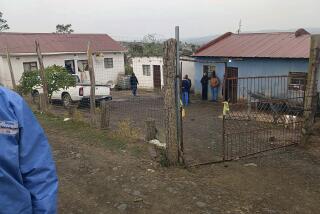8 Killed as Riots Rage in, Around Cape Town
- Share via
JOHANNESBURG, South Africa — At least eight people were killed in anti-government riots in and around Cape Town on Thursday in some of that city’s worst violence in more than a year of civil unrest.
Four of the dead were mixed-race Coloreds killed in clashes with police, and one was a mixed-race man who was helping set up a barricade when he was shot by a passing motorist, raising fears of attacks by white vigilantes.
Three more men, all blacks, were shot and killed by police officers using shotguns to disperse rioters in running battles around the Crossroads squatter settlement outside Cape Town. According to police figures, 63 persons, all blacks or mixed-race except for one white, have died in Cape Town in the last two months.
Elsewhere, two black guerrillas were killed when a bomb that police believe they were planting near a girl’s high school outside Durban blew up late Thursday night. The body of one was ripped apart and thrown 40 yards away. The second man died when a wall of the school collapsed on him.
Whips, Clubs, Water Cannon
In central Cape Town, hundreds of anti-government protesters--Colored youths, black women and white students--were chased through the streets for three hours Thursday afternoon as police, using whips, clubs and a water cannon, attempted to break up their demonstrations.
Scores were injured as the police swept through the downtown streets, initially chasing only nonwhites but later whipping everyone who crossed their paths, including white shoppers, store clerks and office workers, according to reporters who were present. At least 50 persons were arrested.
The government of President Pieter W. Botha has been unable to check the steady escalation and expansion of the violence around Cape Town and much of the Cape of Good Hope area in recent weeks, and the police find themselves coming under gunfire and even grenade attacks almost daily.
Warning motorists that police cannot protect them from attacks by youths throwing stones and firebombs, even on the main national highway up the Cape Peninsula, a police officer suggested that drivers wear motorcycle helmets and other protective gear inside their cars so they can drive even if their windshields are smashed.
Unrest Moves Downtown
With the spread of the protests into central Cape Town on Thursday and into downtown Johannesburg last Friday, the unrest is no longer confined to the outlying black and Colored townships. Increasingly frequent attacks on white motorists, stores and even residential areas have greatly heightened the crisis.
But Botha, seeking to reassure worried white voters before important parliamentary by-elections next week that the unrest is being brought under control, announced on Thursday that he is lifting the three-month-old state of emergency in six rural districts, four in eastern Cape province and two in Transvaal province, because violence there had been reduced.
Thirty magisterial districts in and around Johannesburg, in the Vaal River region south of here and in eastern Cape province remain under the state of emergency, which gives the police virtual martial-law powers. Botha told an election rally that he would not hesitate to extend it to other areas if necessary.
Speaking in Springs, an industrial town 30 miles from Johannesburg, Botha said, “The lifting of the state of emergency in these areas is proof of the effectiveness of these measures in ensuring a return to stability.” Springs is near Kwathema, Duduza and Tsakane, three of the most troubled black townships in the Johannesburg area, and the whole area is under the state of emergency.
3 Deaths Elsewhere
Three more deaths were reported elsewhere in the country. In Soweto, the black satellite city southwest of Johannesburg, a 17-year-old youth was stabbed to death by a gang as a suspected police informer. A few hours later, one of the gang’s leaders, 16, was killed in revenge by the youth’s friends.
Near Craddock in eastern Cape province, the body of a 25-year-old black was found under a pile of burning tires, the form of execution that blacks frequently use for other blacks believed to be government collaborators.
The violence in central Cape Town, coming after last week’s riot in Johannesburg, marked a major escalation in the unrest. In both cases, emboldened youths--Coloreds in Cape Town, blacks in Johannesburg--were clearly ready to take their protests against apartheid, South Africa’s system of racial segregation, into white areas, and they appeared almost unafraid of possible police action.
Arraignments Protested
The Cape Town violence grew largely out of three demonstrations planned by Colored youths and joined by a few whites to protest the arraignment of three Colored men in the killing last month of a police detective during the funeral of a victim of earlier unrest.
The youths were drawn downtown by more than 100 black women who had come from the black ghetto townships of Nyanga, Langa and Guguletu to demand the withdrawal of soldiers from their communities.
More than a dozen South African and foreign journalists, mostly photographers and television crewmen, were arrested during the course of the day, and five complained that they had been assaulted by the police. All were eventually released. Two CBS crewmen, however, were arraigned on charges of violating immigration laws and interfering with the police in the course of their duties.
More to Read
Sign up for Essential California
The most important California stories and recommendations in your inbox every morning.
You may occasionally receive promotional content from the Los Angeles Times.









